| View previous topic :: View next topic |
| Author |
Message |
stevemark

Joined: 29 Apr 2011
Posts: 3754
Location: Switzerland
|
 Posted: Fri Jan 26, 2024 11:56 pm Post subject: Sigma AF 3.5/14mm II cleaning attempt Posted: Fri Jan 26, 2024 11:56 pm Post subject: Sigma AF 3.5/14mm II cleaning attempt |
 |
|
stevemark wrote:
Both versions of the Sigma 3,5/14mm are prone to fogging and even getting oil drops on an inner surface of the lens, resulting in low contrast images and haze.
Here are the two versions - this thread is about the right lens (version II):
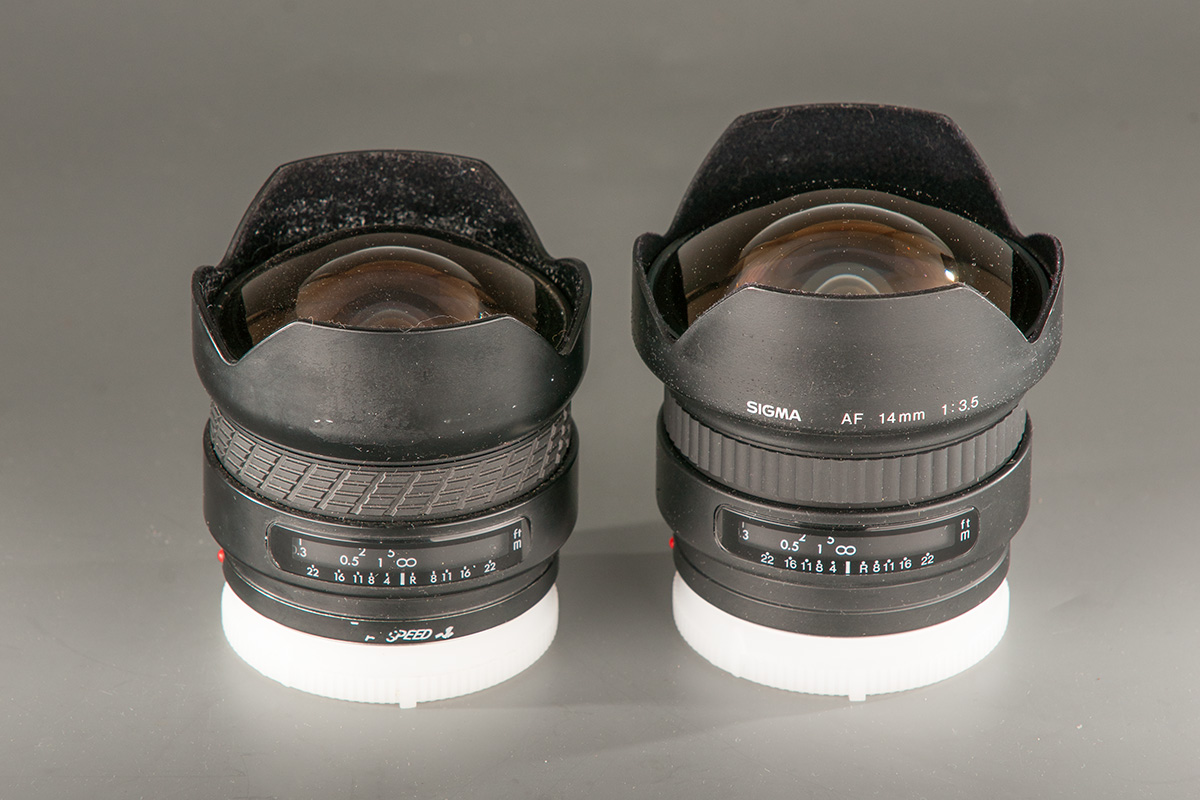
And here's the problem - lots of small oil droplets on an inner glass surface:
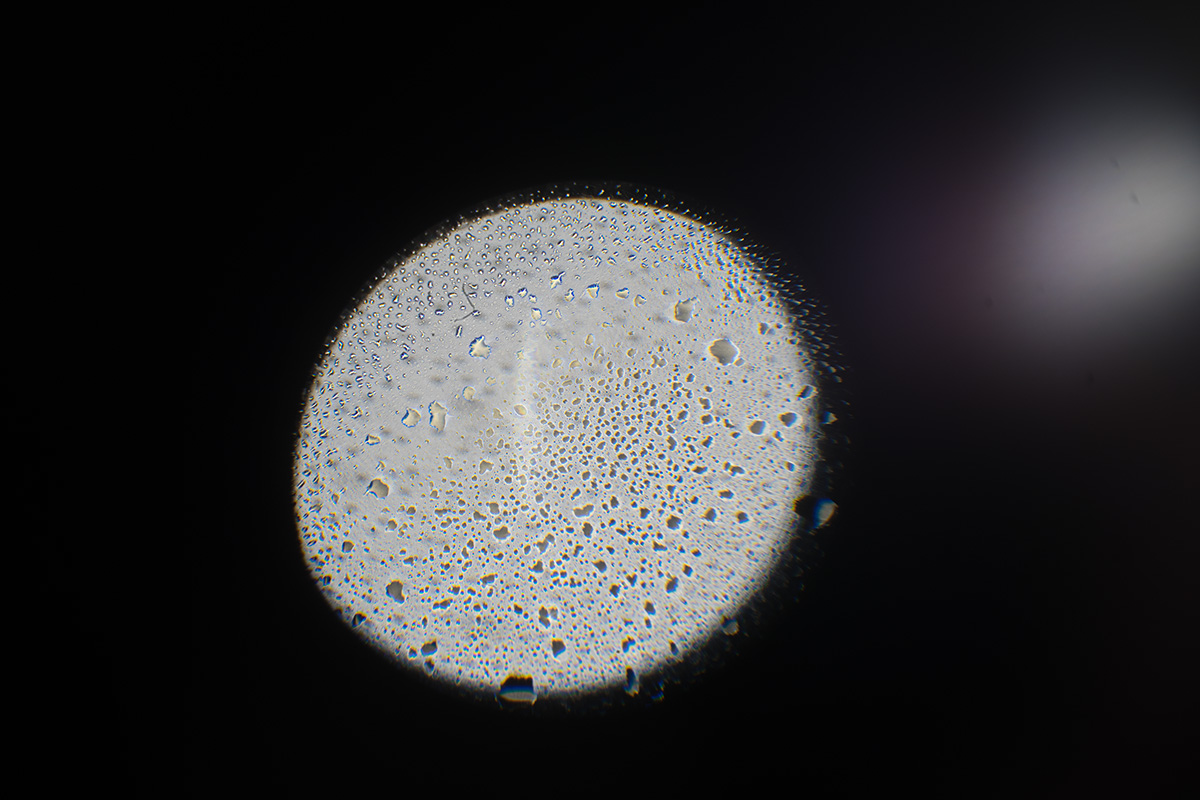
OK, let's begin. Since there's no abvious starting from the front we have to begin at the rear end, removing the bayonet screws. I used some acetone to unblock them:

Then remove the screws for the electric contacts:
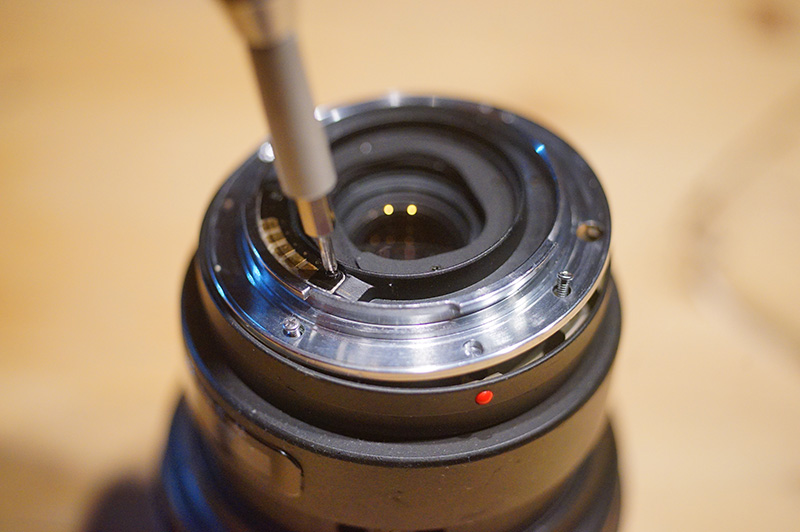
Now we can remove the bayonet mount:

View onto the remaining lens:
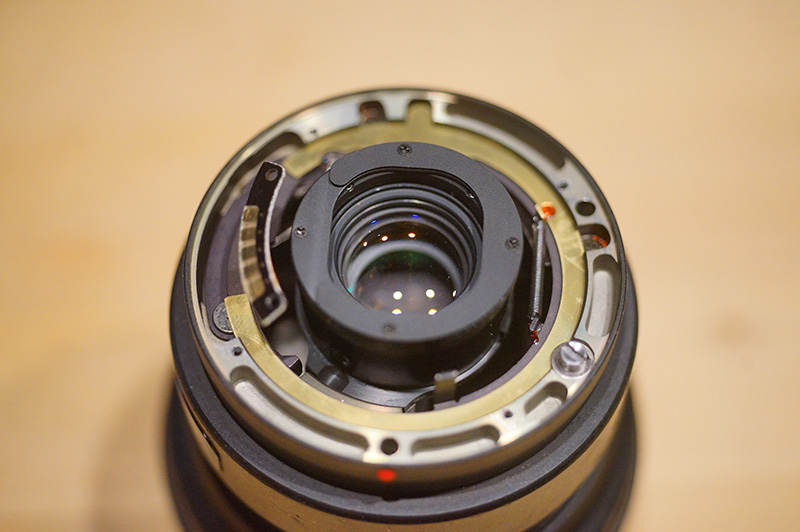
Next set of screws (beware of the red loctite => remove with acetone!):


These are the screws (not equal length!) plus the small U-"ring" for keeping the focus gear in its position:
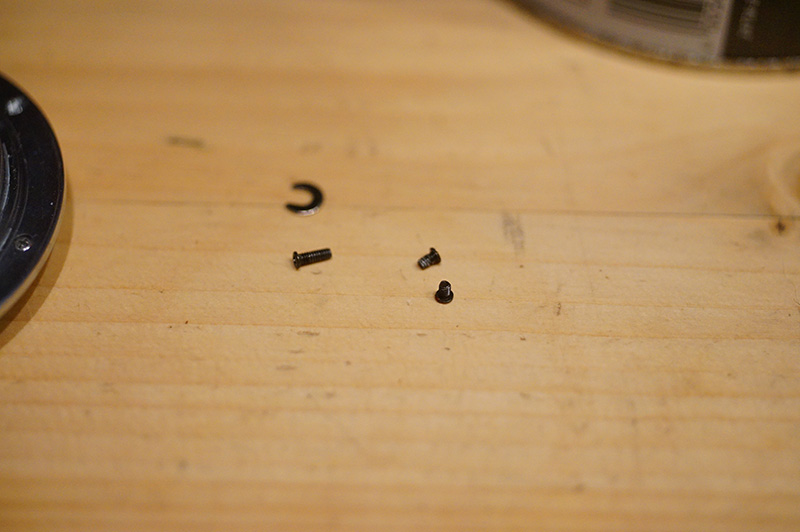

The brass plate is removed:
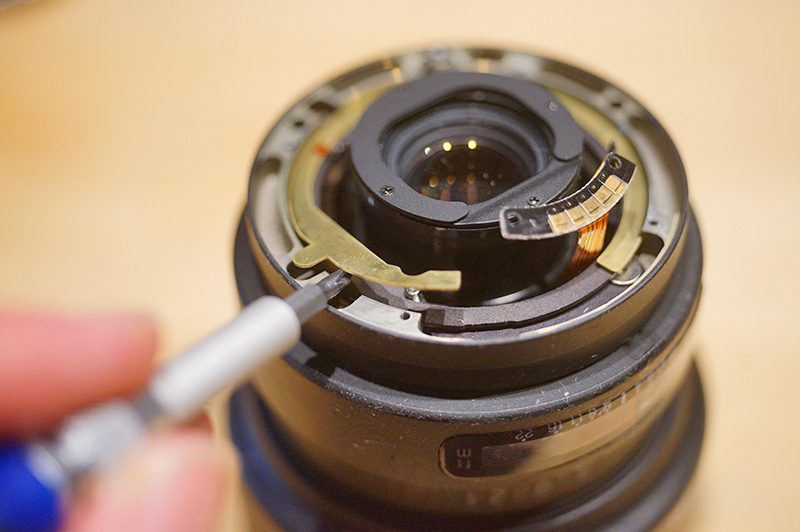

Silver looking part removed:

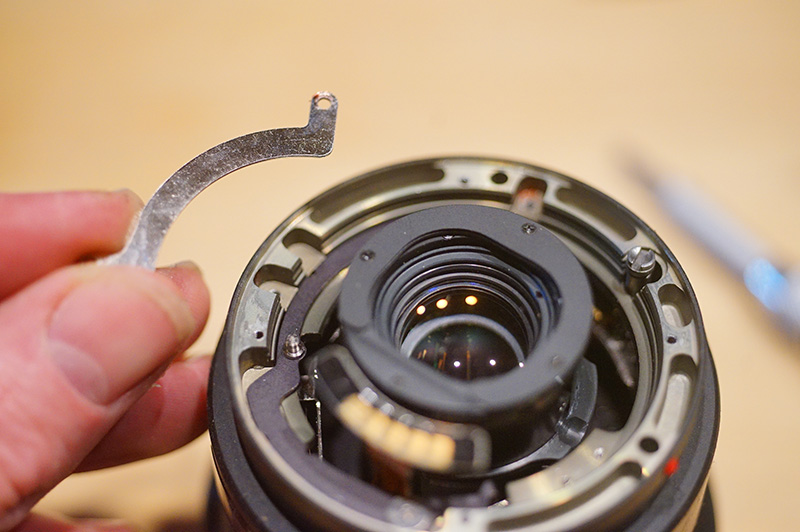
Large screw (aperture mechanism guides) removed:
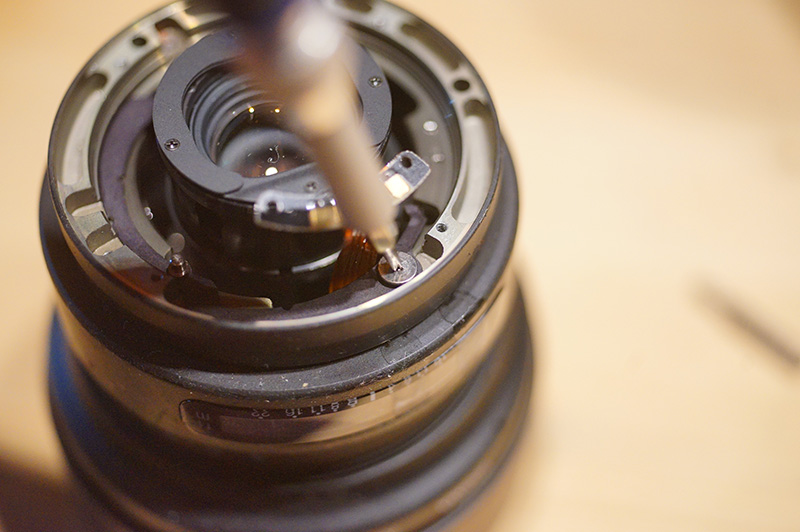
Next part of aperture mechanism transmission removed:

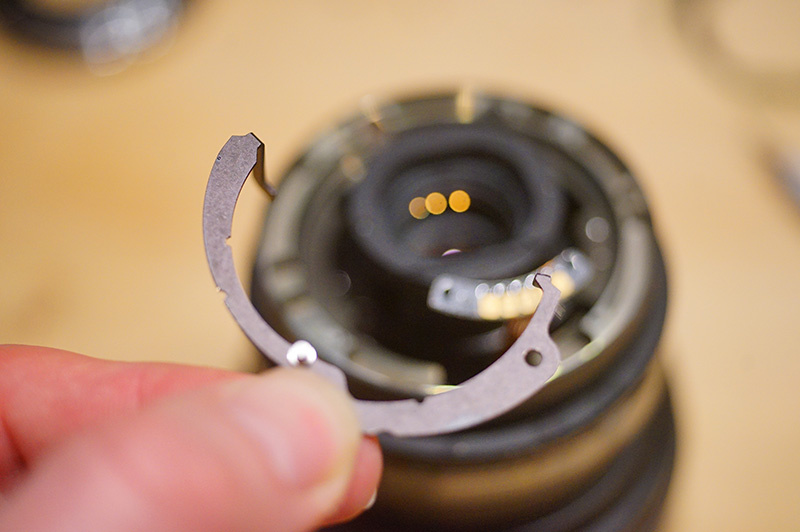
Next set of screws removed:

Next ring comes off:


Shims removed:
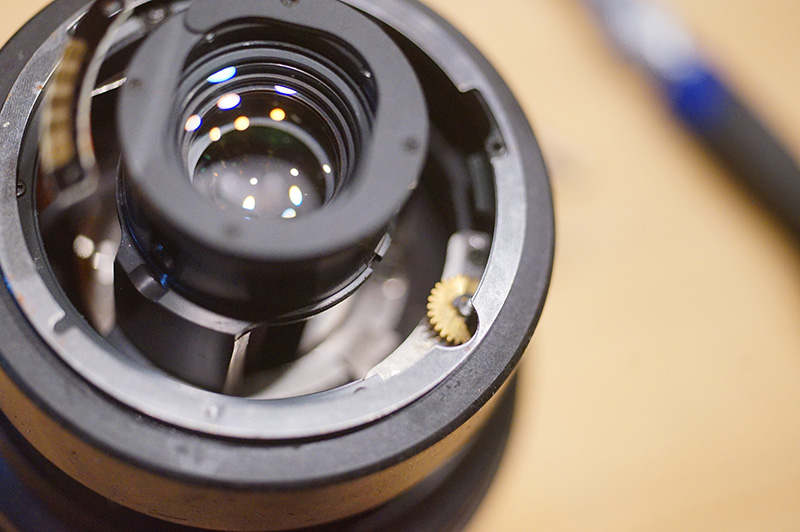
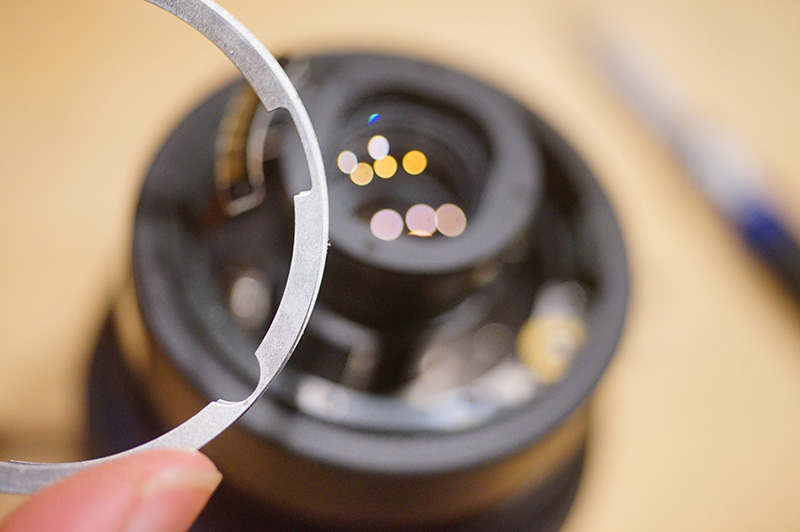
Electronics removed:


Rear baffles removed:
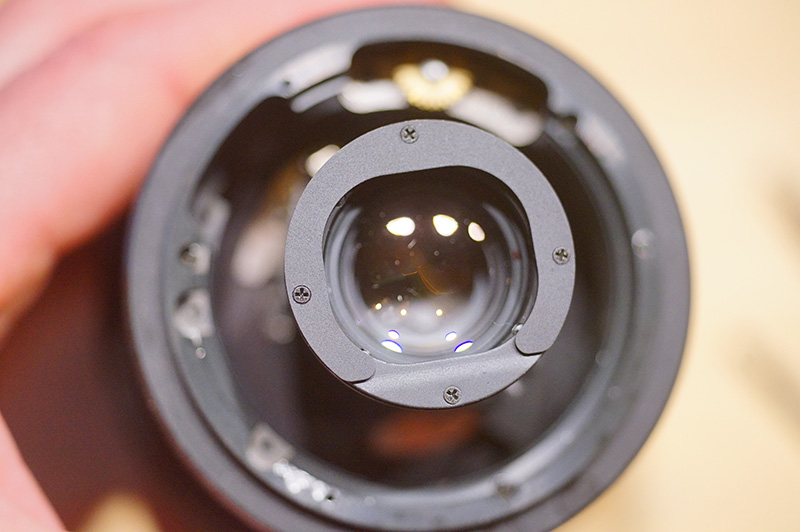
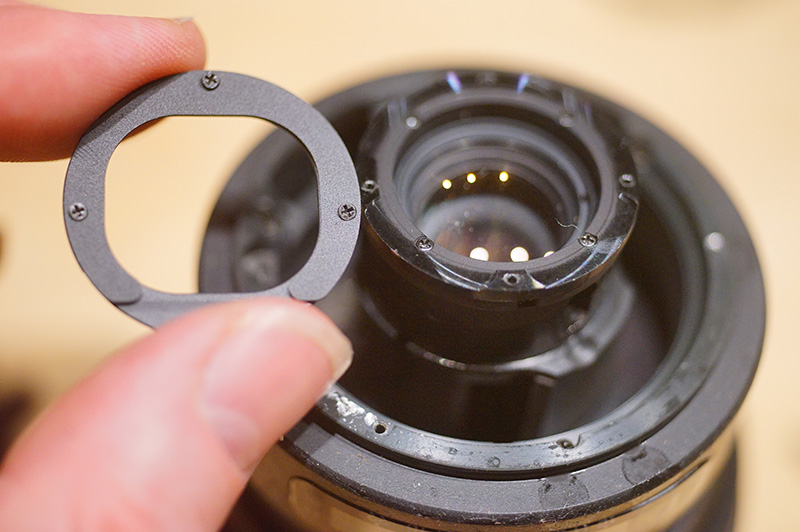
AF gear removed:


Focusing ring removed (middle screw only!):
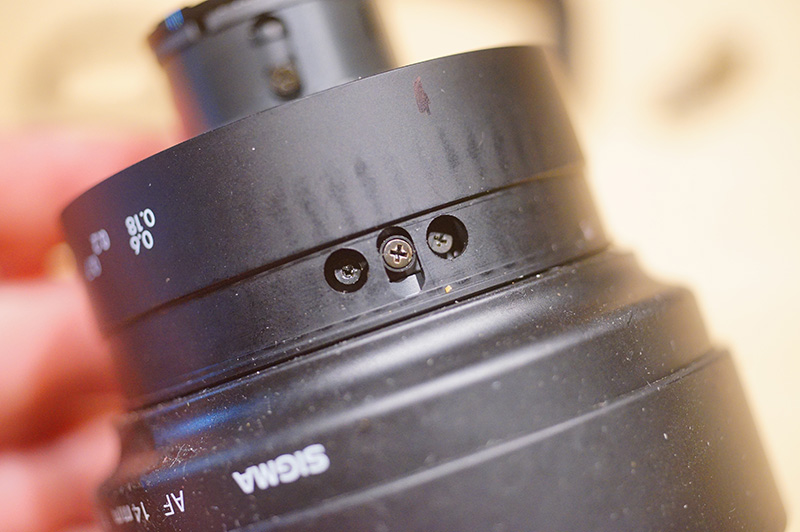

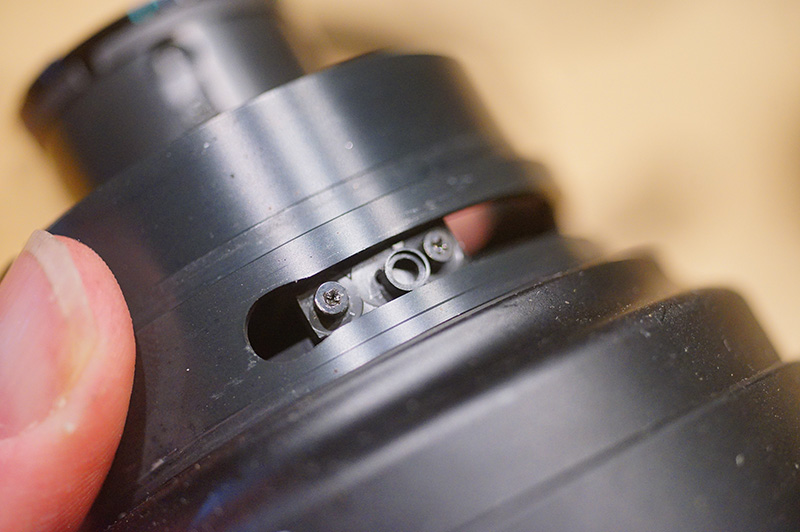
Rear protection ring removed:
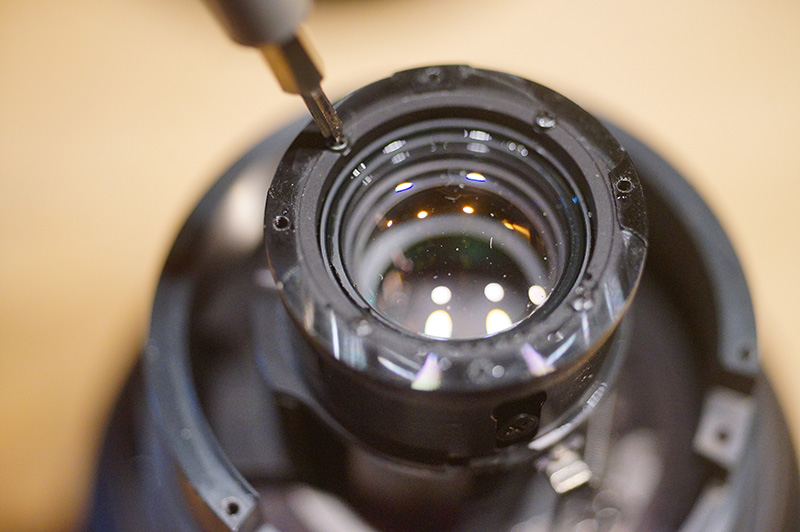

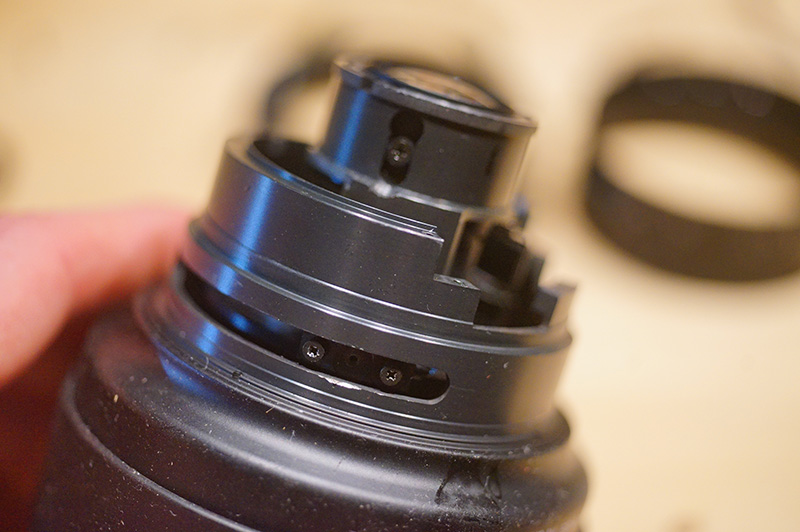
Rear lens element removed (remove the three screws; only one shown here):
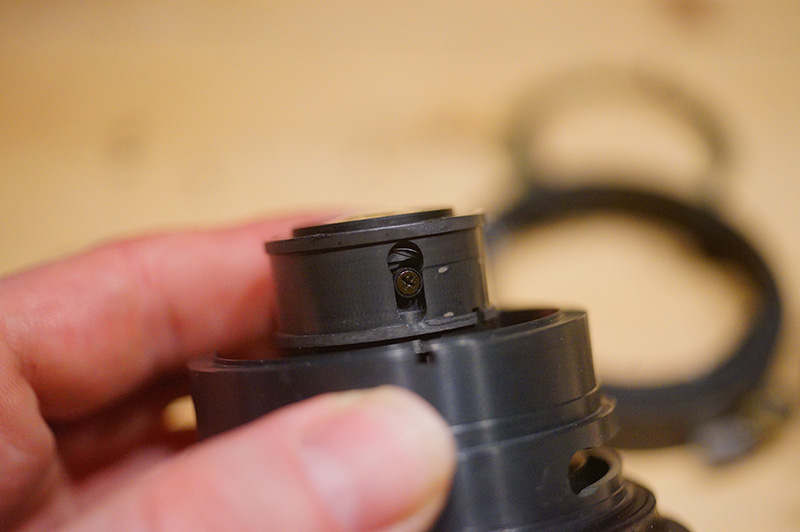
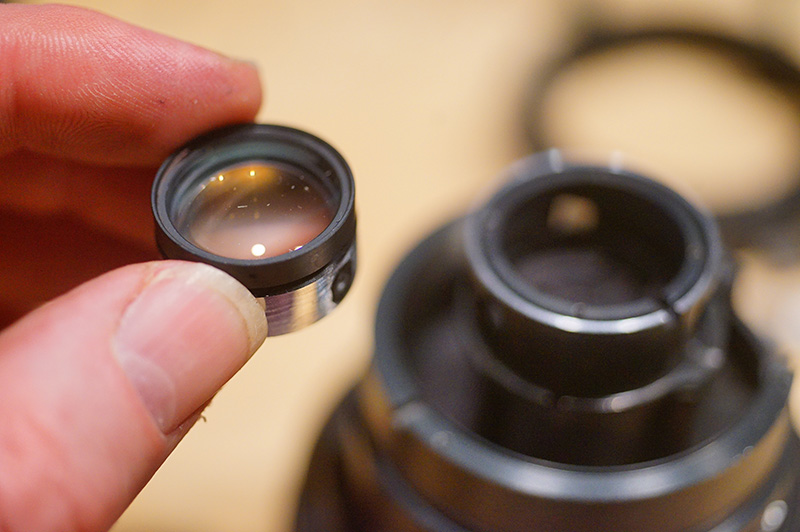
Aperture mechanism now is visible and accesssible:
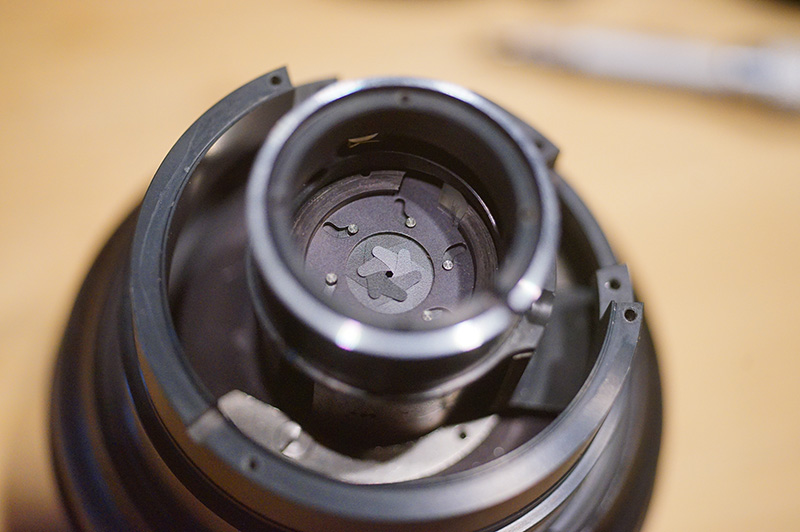
Sadly, it turns out that the the polluted lens surface is NOT just in front to the aperture (the aperture mechanism is completely dry and works perfectly). We'll have to dig deeper ... into the front element.
_________________
www.artaphot.ch
Last edited by stevemark on Sat Jan 27, 2024 12:33 am; edited 1 time in total |
|
| Back to top |
|
 |
stevemark

Joined: 29 Apr 2011
Posts: 3754
Location: Switzerland
|
 Posted: Sat Jan 27, 2024 12:32 am Post subject: Posted: Sat Jan 27, 2024 12:32 am Post subject: |
 |
|
stevemark wrote:
I'm continuing to remove the remaining "transmission gear" for the aperture mechanism:
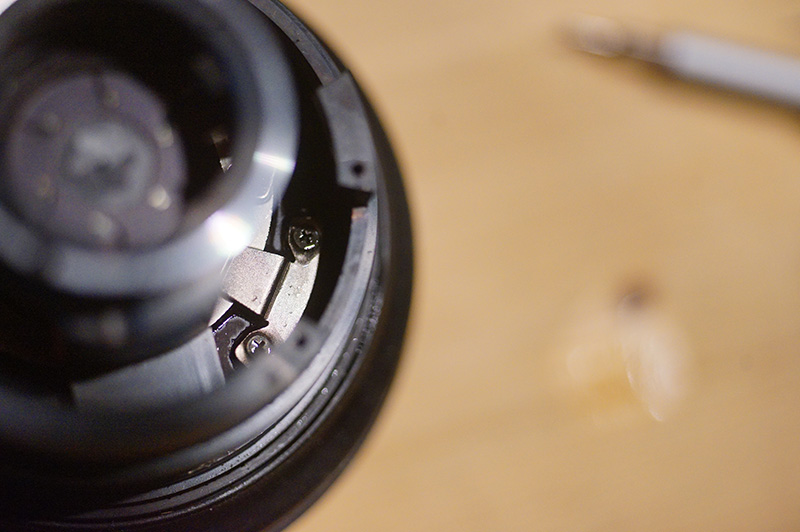
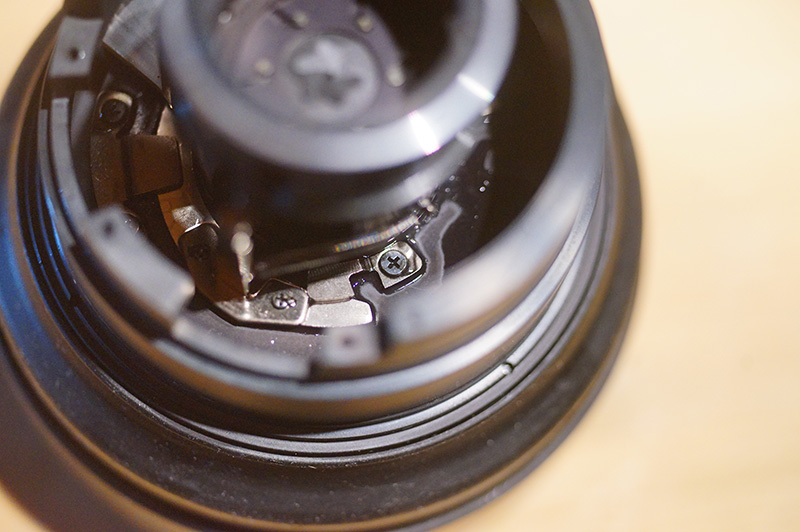


Then I'm stuck. The entire front part now seems to be one massive block. Now screws are visible, and I assume that ons should be able to remove the entire remaining aperture mechanism simply by turning / screwing it out ... but it doesnt work, not even after applying lots of acetone.
then I notice two small holes near the front of the lens. They are threaded, and it seems that there are screws inserted from the other side.

BUT on the other side there's only the large huge bulbuous front lens. No screw heads visible at all!!

SInce there are no crews visible now, I'm a bit lost. I can't unscrew the buil-in lens shade, I wasn't able to unscrew the front lens, and I couldn't do anything from the rear, in spite of lots of acetone.
Any suggestions??
Thanks 
S
_________________
www.artaphot.ch |
|
| Back to top |
|
 |
BrianSVP


Joined: 09 Jun 2023
Posts: 301
Location: Philadelphia
|
 Posted: Sat Jan 27, 2024 2:18 am Post subject: Posted: Sat Jan 27, 2024 2:18 am Post subject: |
 |
|
BrianSVP wrote:
This thread seems to have the info you need:
https://www.flickr.com/groups/1052301@N24/discuss/72157644071963297/ |
|
| Back to top |
|
 |
stevemark

Joined: 29 Apr 2011
Posts: 3754
Location: Switzerland
|
 Posted: Sat Jan 27, 2024 2:35 am Post subject: Posted: Sat Jan 27, 2024 2:35 am Post subject: |
 |
|
stevemark wrote:
Thanks a lot! I had been searching for something like thant, but without success ...
I copy the relevant text here:
| Quote: |
Solution1:
You have to take out the whole lens system from front. There is a thin (2-3mm) metal ring around the front element. You have to get a tumbler or something similar which has the size of the thin metal ring. Then you must put off some double-sided tape onto the tumbler's edge at 2-3 layers. Then put the lens to the desk ( assembled with back cap ) and get some help from another person to hold the lens massively on the desk. Then put the taped tumbler onto the metal ring, push it down very very strongly and try to twist it. BUT!!!!! Be aware!!! You can get very serious injury if the tumbler breaks. So do this absolutely on your risk!!!
Solution2:
Get a drilling machine, and drill 2 holes into the thin metal ring, then you can twist out the lens by a screwdriver and a hammer. This is not a nice solution but works.
When you have managed to get the front element out. You just have to disassembly the whole lens system. All of the ring are glued together, so it won't be easy. Make sure not to injure any of the inner metal tubes, rings and caps, because it won't fit back to it's place.
Good Luck!
PS: I could give these ideas because I have one of these lenses too, also I managed to disassembly it succesfully. However I couldn't remove the fogging from the inner element. |
That's stange. Did he not have access to the respective lens surface? Or was the surface itself not cleanable?
Of course the question remains - what are these strange droplets? Since they didn't come from the aperture mechanism (everything is absolutely dry in there), I'm a bit puzzled. When I got my very first 3.5/14mm (the worst one) I thought of the aspherical element decaying ... most aspheric lenses (and the 3.5/14mm certainly has some) are hybrid plastic/glass lenses. If that thin plastic film decays, well that woulod explain it ...!
S
_________________
www.artaphot.ch |
|
| Back to top |
|
 |
RokkorDoctor


Joined: 27 Nov 2021
Posts: 1268
Location: Kent, UK
|
 Posted: Sat Jan 27, 2024 11:58 am Post subject: Posted: Sat Jan 27, 2024 11:58 am Post subject: |
 |
|
RokkorDoctor wrote:
| stevemark wrote: |
Thanks a lot! I had been searching for something like thant, but without success ...
I copy the relevant text here:
| Quote: |
Solution1:
You have to take out the whole lens system from front. There is a thin (2-3mm) metal ring around the front element. You have to get a tumbler or something similar which has the size of the thin metal ring. Then you must put off some double-sided tape onto the tumbler's edge at 2-3 layers. Then put the lens to the desk ( assembled with back cap ) and get some help from another person to hold the lens massively on the desk. Then put the taped tumbler onto the metal ring, push it down very very strongly and try to twist it. BUT!!!!! Be aware!!! You can get very serious injury if the tumbler breaks. So do this absolutely on your risk!!!
Solution2:
Get a drilling machine, and drill 2 holes into the thin metal ring, then you can twist out the lens by a screwdriver and a hammer. This is not a nice solution but works.
When you have managed to get the front element out. You just have to disassembly the whole lens system. All of the ring are glued together, so it won't be easy. Make sure not to injure any of the inner metal tubes, rings and caps, because it won't fit back to it's place.
Good Luck!
PS: I could give these ideas because I have one of these lenses too, also I managed to disassembly it succesfully. However I couldn't remove the fogging from the inner element. |
That's stange. Did he not have access to the respective lens surface? Or was the surface itself not cleanable?
Of course the question remains - what are these strange droplets? Since they didn't come from the aperture mechanism (everything is absolutely dry in there), I'm a bit puzzled. When I got my very first 3.5/14mm (the worst one) I thought of the aspherical element decaying ... most aspheric lenses (and the 3.5/14mm certainly has some) are hybrid plastic/glass lenses. If that thin plastic film decays, well that woulod explain it ...!
S |
I also have a Sigma 14/3.5 copy (an even older MF one, effectively the MF version of the left one in your image).
This lens has exactly the same issue you discovered, from new when I bought it, years and years ago.
I also tried to take it apart, and after removing the bulbous front as described in the other thread, I just got stuck on too many glued parts in that lens assembly.
Clearly a systemic problem with this lens, and not just my copy...
_________________
Mark
SONY A7S, A7RII + dust-sealed modded Novoflex/Fotodiox/Rayqual MD-NEX adapters
Minolta SR-1, SRT-101/303, XD7/XD11, XGM, X700
Bronica SQAi
Ricoh GX100
Minolta majority of all Rokkor SR/AR/MC/MD models made
Sigma 14mm/3.5 for SR mount
Tamron SP 60B 300mm/2.8 (Adaptall)
Samyang T-S 24mm/3.5 (Nikon mount, DIY converted to SR mount)
Schneider-Kreuznach PC-Super-Angulon 28mm/2.8 (SR mount)
Bronica PS 35/40/50/65/80/110/135/150/180/200/250mm |
|
| Back to top |
|
 |
BrianSVP


Joined: 09 Jun 2023
Posts: 301
Location: Philadelphia
|
 Posted: Sat Jan 27, 2024 4:46 pm Post subject: Posted: Sat Jan 27, 2024 4:46 pm Post subject: |
 |
|
BrianSVP wrote:
From experience with the Mini and Super Wides, I can tell you that, as in your experience, it's not typically the element adjacent to the blades that fogs on them.
On some lenses, such as some of the Canon FDs, there are rubber gaskets that can outgas and cause condensation like this, but the Sigmas don't typically use them, so it seems to be something else. It's always the same element that is affected in any given model, so it may even be something in the particular coating on that element that is breaking down? It definitely occurs on air-exposed surfaces, so it's not cement separation that causes the milkiness.
It's also not always cleanable, often leaving a milky discoloration even once the droplets are removed, so the coating is definitely either degrading itself or is being degraded by whatever the liquid is. It could very well be that the person in the thread ran into this.
| stevemark wrote: |
Thanks a lot! I had been searching for something like thant, but without success ...
I copy the relevant text here:
| Quote: |
Solution1:
You have to take out the whole lens system from front. There is a thin (2-3mm) metal ring around the front element. You have to get a tumbler or something similar which has the size of the thin metal ring. Then you must put off some double-sided tape onto the tumbler's edge at 2-3 layers. Then put the lens to the desk ( assembled with back cap ) and get some help from another person to hold the lens massively on the desk. Then put the taped tumbler onto the metal ring, push it down very very strongly and try to twist it. BUT!!!!! Be aware!!! You can get very serious injury if the tumbler breaks. So do this absolutely on your risk!!!
Solution2:
Get a drilling machine, and drill 2 holes into the thin metal ring, then you can twist out the lens by a screwdriver and a hammer. This is not a nice solution but works.
When you have managed to get the front element out. You just have to disassembly the whole lens system. All of the ring are glued together, so it won't be easy. Make sure not to injure any of the inner metal tubes, rings and caps, because it won't fit back to it's place.
Good Luck!
PS: I could give these ideas because I have one of these lenses too, also I managed to disassembly it succesfully. However I couldn't remove the fogging from the inner element. |
That's stange. Did he not have access to the respective lens surface? Or was the surface itself not cleanable?
Of course the question remains - what are these strange droplets? Since they didn't come from the aperture mechanism (everything is absolutely dry in there), I'm a bit puzzled. When I got my very first 3.5/14mm (the worst one) I thought of the aspherical element decaying ... most aspheric lenses (and the 3.5/14mm certainly has some) are hybrid plastic/glass lenses. If that thin plastic film decays, well that woulod explain it ...!
S |
|
|
| Back to top |
|
 |
stevemark

Joined: 29 Apr 2011
Posts: 3754
Location: Switzerland
|
 Posted: Sat Jan 27, 2024 8:59 pm Post subject: Posted: Sat Jan 27, 2024 8:59 pm Post subject: |
 |
|
stevemark wrote:
| RokkorDoctor wrote: |
I also have a Sigma 14/3.5 copy (an even older MF one, effectively the MF version of the left one in your image).
This lens has exactly the same issue you discovered, from new when I bought it, years and years ago.
I also tried to take it apart, and after removing the bulbous front as described in the other thread, I just got stuck on too many glued parts in that lens assembly.
Clearly a systemic problem with this lens, and not just my copy... |
Good to know. I suspected some trouble ahead, and therefore bought a second Sigma AF 3.5/14mm II when the opportunity arose. I now can "play hard" with the first sample, and then repair the second one ...
| BrianSVP wrote: |
From experience with the Mini and Super Wides, I can tell you that, as in your experience, it's not typically the element adjacent to the blades that fogs on them.
On some lenses, such as some of the Canon FDs, there are rubber gaskets that can outgas and cause condensation like this, but the Sigmas don't typically use them, so it seems to be something else. |
Agreed.
| BrianSVP wrote: |
| It's always the same element that is affected in any given model, so it may even be something in the particular coating on that element that is breaking down? It definitely occurs on air-exposed surfaces, so it's not cement separation that causes the milkiness. |
As I said at least the 3.5/14mm probably has some hybrid aspherics (i. e. spherical glass lens with a very thin aspherical plastic surface). It was Minolta who first used these hybrid aspherical lenses, e. g. in their MD/AF 28-85mm and AF 4/35-70mm lenses. I didn't find a lens diagram of either version of the Sigma 3.5/14mm, but the later 2.8 version has its aspherical hybrid lens right there were we have the problems also in the f3.5 superwide. This of course is bad news.
BTW the use of a aspherical hybrid lens in the Sigma 2.8/24mm super wide II would also explain the surprisingly good performance of the lens!
| BrianSVP wrote: |
| It's also not always cleanable, often leaving a milky discoloration even once the droplets are removed, so the coating is definitely either degrading itself or is being degraded by whatever the liquid is. It could very well be that the person in the thread ran into this. |
Another sign pointing to the degradation / dissolution of the aspherical plastic surface applied onto a spherical glass lens ...
I'll have some work in Italy during the next days, so further work on the Sigma 3.5/14mm is postponed until I return.
S
_________________
www.artaphot.ch |
|
| Back to top |
|
 |
RokkorDoctor


Joined: 27 Nov 2021
Posts: 1268
Location: Kent, UK
|
 Posted: Sat Jan 27, 2024 9:37 pm Post subject: Posted: Sat Jan 27, 2024 9:37 pm Post subject: |
 |
|
RokkorDoctor wrote:
I have seen a few lenses that have a similar issue.
The Minolta MD 35-135/3.5-4.5 seems to have a similar problem; many of those I have seen developed droplets & haze on the inside surface of the rearmost element.
From memory I have once seen a diagram of the later Minolta AF 35-105/3.5-4.5 which is very similar, and that had an "anti-fogging compound" indicated around the perimeter of that last lens element (possibly some form of sealing compound). I do remember that as it caught my eye at the time, given the numerous fogged-up rear elements I had seen on the nearly identical MD 35-135 lenses.
I suspect that depending on lens glass composition, polishing method and coating composition some lens surfaces can exhibit hygroscopic behaviour. Many temperature fluctuations together with a not perfect hermetic seal could then lead to condensation inside otherwise apparently perfectly sealed air spaces.
This is just a theory; outgassing of polymer aspherics may be another potential problem; both acrylic as well as polycarbonate absorb some moisture from the air.
_________________
Mark
SONY A7S, A7RII + dust-sealed modded Novoflex/Fotodiox/Rayqual MD-NEX adapters
Minolta SR-1, SRT-101/303, XD7/XD11, XGM, X700
Bronica SQAi
Ricoh GX100
Minolta majority of all Rokkor SR/AR/MC/MD models made
Sigma 14mm/3.5 for SR mount
Tamron SP 60B 300mm/2.8 (Adaptall)
Samyang T-S 24mm/3.5 (Nikon mount, DIY converted to SR mount)
Schneider-Kreuznach PC-Super-Angulon 28mm/2.8 (SR mount)
Bronica PS 35/40/50/65/80/110/135/150/180/200/250mm |
|
| Back to top |
|
 |
kiddo

Joined: 29 Jun 2018
Posts: 1121
|
 Posted: Mon Jan 29, 2024 12:29 am Post subject: Posted: Mon Jan 29, 2024 12:29 am Post subject: |
 |
|
kiddo wrote:
I'm just amazed of the amount of knowledge you guys show, seems like any lens would be so easy deal to work on
I do have an old trioplan 7,5cm 2.9 from folding Balda that shares same looking droplets , I was able to open but there were damages in the coatings (Schneideritis?).
Of course the age of this lens has nothing to do with this af lens,but the blades of that lens also were totally clean .
Definitely some coatings gotta be weaker than others ,I am curious to see how will the story finish, as there might be also the option that would be cleanable.
By the way Steve, what JIS screwdrivers are you using? I've tried unlocking red loctite on yashica ml 1.4 with acetone with no succes, at least it worked in your lens. I understand there are many kind of red loctite ? |
|
| Back to top |
|
 |
RokkorDoctor


Joined: 27 Nov 2021
Posts: 1268
Location: Kent, UK
|
 Posted: Mon Jan 29, 2024 12:32 pm Post subject: Posted: Mon Jan 29, 2024 12:32 pm Post subject: |
 |
|
RokkorDoctor wrote:
| kiddo wrote: |
I'm just amazed of the amount of knowledge you guys show, seems like any lens would be so easy deal to work on
I do have an old trioplan 7,5cm 2.9 from folding Balda that shares same looking droplets , I was able to open but there were damages in the coatings (Schneideritis?).
Of course the age of this lens has nothing to do with this af lens,but the blades of that lens also were totally clean .
Definitely some coatings gotta be weaker than others ,I am curious to see how will the story finish, as there might be also the option that would be cleanable.
By the way Steve, what JIS screwdrivers are you using? I've tried unlocking red loctite on yashica ml 1.4 with acetone with no succes, at least it worked in your lens. I understand there are many kind of red loctite ? |
Schneideritis is not a coating issue, rather it refers to an issue with the edge blacking on lens elements. On some lenses the lens blacking starts to separate from the lens, usually in many small spots all over the lens edge. From the front this gives the edge of the lens a white spotted appearance. Although referred to as "Schneideritis", this problem can affect lenses of many brands.
The small droplets issue I also once had on an internal element of a Schneider-Kreuznach PC Super Angulon 28/2.8 (the older, shift-only version). After disassembly that surface was cleaned easily with some IPA. That element was also NOT adjacent to the aperture. I just checked it and that lens is still clean, no sign of droplets recurring.
I'm not sure what screwdrivers Stephan uses, but I can recommend two brands that are relatively easily available in the UK through Amazon: VESSEL and ENGINEER. Both are quality Japanese-manufactured screwdrivers.
VESSEL TD56S:
https://www.amazon.co.uk/Vessel-VESSEL-Precision-Screwdriver-TD-56S/dp/B07BYV6PF6/ref=sr_1_1
These are JIS crosshead tips, and one of the few sets that go down to no. 0000
ENGINEER 6-piece precision screwdrivers:
https://www.amazon.co.uk/Precision-Screwdriver-Phillips-Custom-ENGINEER/dp/B06XXXVPRY/ref=sr_1_15
This ENGINEER screwdriver set may look like the generic cheap Chinese sets, but they are not. Although still a budget-set, they are of Japanese manufacture and are of far higher quality that the cheap Chinese ones you see everywhere. The tips are Phillips, but machined accurately enough that they give a decent (not perfect) fit in JIS screws.
To be fair, in my experience once you get down to ⊕000 or smaller, although it matters in theory the JIS vs Phillips issue becomes a little more academic and one for varying machining tolerances. At those small head sizes the difference between the Phillips vs. JIS geometry becomes difficult to manufacture accurately in machined driver heads. Just try and find a screwdriver that feels like it engages the head of the screw really well, and maintain enough downward pressure to avoid cam-out.
Screws that are really stuck may end up damaged no matter what you try, even on new items (yes, I am looking at you Fotodiox!!!)
_________________
Mark
SONY A7S, A7RII + dust-sealed modded Novoflex/Fotodiox/Rayqual MD-NEX adapters
Minolta SR-1, SRT-101/303, XD7/XD11, XGM, X700
Bronica SQAi
Ricoh GX100
Minolta majority of all Rokkor SR/AR/MC/MD models made
Sigma 14mm/3.5 for SR mount
Tamron SP 60B 300mm/2.8 (Adaptall)
Samyang T-S 24mm/3.5 (Nikon mount, DIY converted to SR mount)
Schneider-Kreuznach PC-Super-Angulon 28mm/2.8 (SR mount)
Bronica PS 35/40/50/65/80/110/135/150/180/200/250mm |
|
| Back to top |
|
 |
BrianSVP


Joined: 09 Jun 2023
Posts: 301
Location: Philadelphia
|
 Posted: Mon Jan 29, 2024 2:38 pm Post subject: Posted: Mon Jan 29, 2024 2:38 pm Post subject: |
 |
|
BrianSVP wrote:
Just want to add that if you can find them in the UK, the plastic-handled US-made Moody Pollicis drivers are definitely worth a try. The ergonomics are just so much better than the typical metal-handled jeweler-style drivers. I've not tried the Engineers, but I've used that same Vessel set, and find the Pollicis significantly superior in both ergonomics and the durability of the bits, which are hardened vanadium steel.
Moody makes both fixed and interchangeable bit versions. The interchangeables are more economical, but can be more fiddly to use, so I prefer the fixed handle ones.
Fixed JIS:
https://www.micro-tools.com/collections/moody-tools/products/58-0405
Interchangeable JIS:
https://www.micro-tools.com/collections/moody-tools/products/55-0318
They also make pretty much any other style of driver bit you can think of.
| RokkorDoctor wrote: |
I'm not sure what screwdrivers Stephan uses, but I can recommend two brands that are relatively easily available in the UK through Amazon: VESSEL and ENGINEER. Both are quality Japanese-manufactured screwdrivers.
VESSEL TD56S:
https://www.amazon.co.uk/Vessel-VESSEL-Precision-Screwdriver-TD-56S/dp/B07BYV6PF6/ref=sr_1_1
These are JIS crosshead tips, and one of the few sets that go down to no. 0000
ENGINEER 6-piece precision screwdrivers:
https://www.amazon.co.uk/Precision-Screwdriver-Phillips-Custom-ENGINEER/dp/B06XXXVPRY/ref=sr_1_15
This ENGINEER screwdriver set may look like the generic cheap Chinese sets, but they are not. Although still a budget-set, they are of Japanese manufacture and are of far higher quality that the cheap Chinese ones you see everywhere. The tips are Phillips, but machined accurately enough that they give a decent (not perfect) fit in JIS screws.
To be fair, in my experience once you get down to ⊕000 or smaller, although it matters in theory the JIS vs Phillips issue becomes a little more academic and one for varying machining tolerances. At those small head sizes the difference between the Phillips vs. JIS geometry becomes difficult to manufacture accurately in machined driver heads. Just try and find a screwdriver that feels like it engages the head of the screw really well, and maintain enough downward pressure to avoid cam-out.
Screws that are really stuck may end up damaged no matter what you try, even on new items (yes, I am looking at you Fotodiox!!!) |
|
|
| Back to top |
|
 |
BrianSVP


Joined: 09 Jun 2023
Posts: 301
Location: Philadelphia
|
 Posted: Mon Jan 29, 2024 3:07 pm Post subject: Posted: Mon Jan 29, 2024 3:07 pm Post subject: |
 |
|
BrianSVP wrote:
The Hybrid Aspherical hypothesis is an interesting one, but I'm not sure the dates line up.
The Sigma Mini-Wide II, which has this same problem in all versions, was introduced in 1986:
https://lens-club.ru/lenses/item/c_652.html#
This 14mm was introduced in 1991:
https://lens-club.ru/lenses/item/c_3421.html
Nikon supposedly introduced the first lens with a hybrid ASPH element, i.e. not a molded/ground glass or all-plastic) in 1991, in the AF Nikkor 28-70mm f/3.5-4.5D. Tamron, the first documented non-OEM to use one, started using hybrids in 1993 in their 28-200mm f/3.8-5.6. Note also that both of these lenses are lightweight zooms.
Now Sigma did definitely use such an element in the later 14mm f/2.8 EX DG ASPH (it's right there in the name!), but that wasn't released until 1998.
Could it be that Sigma was experimenting with this kind of thing earlier? Perhaps, but you'd think such at-the-time cutting edge technology would be something they would advertise far and wide, not something they'd sneak in without telling anyone.
| stevemark wrote: |
| RokkorDoctor wrote: |
I also have a Sigma 14/3.5 copy (an even older MF one, effectively the MF version of the left one in your image).
This lens has exactly the same issue you discovered, from new when I bought it, years and years ago.
I also tried to take it apart, and after removing the bulbous front as described in the other thread, I just got stuck on too many glued parts in that lens assembly.
Clearly a systemic problem with this lens, and not just my copy... |
Good to know. I suspected some trouble ahead, and therefore bought a second Sigma AF 3.5/14mm II when the opportunity arose. I now can "play hard" with the first sample, and then repair the second one ...
| BrianSVP wrote: |
From experience with the Mini and Super Wides, I can tell you that, as in your experience, it's not typically the element adjacent to the blades that fogs on them.
On some lenses, such as some of the Canon FDs, there are rubber gaskets that can outgas and cause condensation like this, but the Sigmas don't typically use them, so it seems to be something else. |
Agreed.
| BrianSVP wrote: |
| It's always the same element that is affected in any given model, so it may even be something in the particular coating on that element that is breaking down? It definitely occurs on air-exposed surfaces, so it's not cement separation that causes the milkiness. |
As I said at least the 3.5/14mm probably has some hybrid aspherics (i. e. spherical glass lens with a very thin aspherical plastic surface). It was Minolta who first used these hybrid aspherical lenses, e. g. in their MD/AF 28-85mm and AF 4/35-70mm lenses. I didn't find a lens diagram of either version of the Sigma 3.5/14mm, but the later 2.8 version has its aspherical hybrid lens right there were we have the problems also in the f3.5 superwide. This of course is bad news.
BTW the use of a aspherical hybrid lens in the Sigma 2.8/24mm super wide II would also explain the surprisingly good performance of the lens!
| BrianSVP wrote: |
| It's also not always cleanable, often leaving a milky discoloration even once the droplets are removed, so the coating is definitely either degrading itself or is being degraded by whatever the liquid is. It could very well be that the person in the thread ran into this. |
Another sign pointing to the degradation / dissolution of the aspherical plastic surface applied onto a spherical glass lens ...
I'll have some work in Italy during the next days, so further work on the Sigma 3.5/14mm is postponed until I return.
S |
[/i] |
|
| Back to top |
|
 |
RokkorDoctor


Joined: 27 Nov 2021
Posts: 1268
Location: Kent, UK
|
 Posted: Mon Jan 29, 2024 5:09 pm Post subject: Posted: Mon Jan 29, 2024 5:09 pm Post subject: |
 |
|
RokkorDoctor wrote:
| BrianSVP wrote: |
Just want to add that if you can find them in the UK, the plastic-handled US-made Moody Pollicis drivers are definitely worth a try. The ergonomics are just so much better than the typical metal-handled jeweler-style drivers. I've not tried the Engineers, but I've used that same Vessel set, and find the Pollicis significantly superior in both ergonomics and the durability of the bits, which are hardened vanadium steel.
Moody makes both fixed and interchangeable bit versions. The interchangeables are more economical, but can be more fiddly to use, so I prefer the fixed handle ones.
Fixed JIS:
https://www.micro-tools.com/collections/moody-tools/products/58-0405
Interchangeable JIS:
https://www.micro-tools.com/collections/moody-tools/products/55-0318
They also make pretty much any other style of driver bit you can think of.
| RokkorDoctor wrote: |
I'm not sure what screwdrivers Stephan uses, but I can recommend two brands that are relatively easily available in the UK through Amazon: VESSEL and ENGINEER. Both are quality Japanese-manufactured screwdrivers.
VESSEL TD56S:
https://www.amazon.co.uk/Vessel-VESSEL-Precision-Screwdriver-TD-56S/dp/B07BYV6PF6/ref=sr_1_1
These are JIS crosshead tips, and one of the few sets that go down to no. 0000
ENGINEER 6-piece precision screwdrivers:
https://www.amazon.co.uk/Precision-Screwdriver-Phillips-Custom-ENGINEER/dp/B06XXXVPRY/ref=sr_1_15
This ENGINEER screwdriver set may look like the generic cheap Chinese sets, but they are not. Although still a budget-set, they are of Japanese manufacture and are of far higher quality that the cheap Chinese ones you see everywhere. The tips are Phillips, but machined accurately enough that they give a decent (not perfect) fit in JIS screws.
To be fair, in my experience once you get down to ⊕000 or smaller, although it matters in theory the JIS vs Phillips issue becomes a little more academic and one for varying machining tolerances. At those small head sizes the difference between the Phillips vs. JIS geometry becomes difficult to manufacture accurately in machined driver heads. Just try and find a screwdriver that feels like it engages the head of the screw really well, and maintain enough downward pressure to avoid cam-out.
Screws that are really stuck may end up damaged no matter what you try, even on new items (yes, I am looking at you Fotodiox!!!) |
|
Those Moody Pollicis screwdrivers do seem available here in the UK, but only from 2 sources I can easily find, and fairly pricey at that.
I once had a similar UK-manufactured high-quality Starrett set of precision screwdrivers with hardened vanadium steel, but found them a bit too brittle. They were less likely to get rounded off, but more likely to snap on repeated use due to fatigue. On stuck screws I prefer screwdrivers with a bit more tensile strength. Precision screwdrivers used on old stuck screws do tend to get regular damage; at £10-12 a piece that cost gets a bit high for me.
It depends on one's personal preferences I guess; the only way to find out is to get a few different brand / hardness screwdrivers and see which one one prefers. It also depends on the lenses one works on whether a damaged screw or a damaged driver is the more palatable outcome.
Occasionally I have found a set of very cheap precision screwdrivers or bits that happened to be well-made (it happens, you get good lucky batches sometimes). My wife never understood why I would then stock up on those... 
_________________
Mark
SONY A7S, A7RII + dust-sealed modded Novoflex/Fotodiox/Rayqual MD-NEX adapters
Minolta SR-1, SRT-101/303, XD7/XD11, XGM, X700
Bronica SQAi
Ricoh GX100
Minolta majority of all Rokkor SR/AR/MC/MD models made
Sigma 14mm/3.5 for SR mount
Tamron SP 60B 300mm/2.8 (Adaptall)
Samyang T-S 24mm/3.5 (Nikon mount, DIY converted to SR mount)
Schneider-Kreuznach PC-Super-Angulon 28mm/2.8 (SR mount)
Bronica PS 35/40/50/65/80/110/135/150/180/200/250mm |
|
| Back to top |
|
 |
stevemark

Joined: 29 Apr 2011
Posts: 3754
Location: Switzerland
|
 Posted: Mon Jan 29, 2024 6:46 pm Post subject: Posted: Mon Jan 29, 2024 6:46 pm Post subject: |
 |
|
stevemark wrote:
I'm not doing lots of repairs, but enough to know the problem of stuck screws, and screwdrivers too brittle to manage the torque.
Interestingly, since I started to routinely apply solvents (usually aceton, occasionally WD40) to any slightly stuck screw there were no failures any more.
As I said - maybe I simply don't do enough repairwork ... 
S
_________________
www.artaphot.ch |
|
| Back to top |
|
 |
|
|
